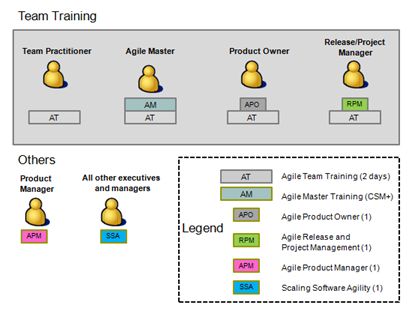Pete Behrens (www.trailridgeconsulting.com) and I were formulating a training strategy for a significant enterprise that is contemplating an “all in” (immediate and across the entire company) enterprise scale transformation approach. Based on my experiences at BMC Software and his experiences at Salesforce.com, as well as some of our larger, ongoing clients, we had a chance to reflect on what we would recommend as the “right” amount of training to ensure success. We concluded that for the enterprise, a combination of team-based and role-based training that would touch every practitioner is ideal. The summary of our training recommendations by role is seen in the figure below:
With this model, all team practitioners receive a minimum of two days of agile training, (agile team training for the each team in the enterprise) which we recommend as the minimum requirement, with an additional day or so of training for specialized roles of Product Owner, Project/Release Manager, and Agile/Scrum Master. All other executives and managers are invited to attend an overview course on scaling software agility.
Each of these courses is described in summary form below.
Agile for Teams –Essential, team-based training in a two day workshop setting that introduces the philosophy, principles, and benefits of agility, agile methods, iterative and release framework, roles, agile technical practices, and agile management practices (Scrum). This is an interactive workshop with a specific project context producing a draft release plan and first iteration (sprint) plan. Training should also include those enterprise extensions applicable to the company’s context.
Agile Release and Project Management at Enterprise Scale – For Project Managers, Release Managers, Program and Portfolio Managers who have responsibility for helping deliver the product(s) to the marketplace. Topics include differences between traditional and agile product management, iteration framework, multi-level release planning and tracking, the agile release train, planning and executing the release planning event, and measuring enterprise progress.
Agile Product Owner in the Enterprise – For team-based product owners/candidates who will become responsible for backlog management, story writing, and iteration and release planning, and who will also be involved in the planning and coordination of larger scale software systems of systems built by teams of teams.
The Agile Master In The Enterprise – For potential agile team leads/future Scrum Masters who will be coaching agile teams and who will interact with other teams as well. Topics include: process facilitation, enterprise agility, mastering the iteration, team roles, release planning and tracking, agile leadership, empowerment and conflict management, and integration Scrums.
Agile Product Manager in the Enterprise – For enterprise product managers with product, product line, portfolio and business unit responsibilities. Topics include: what’s so different about agile, backlog and prioritization, relationship to product owners, PM’s role in release planning and management, visioning and the product roadmap.
Scaling Software Agility – Best Practices for Large Enterprises – For executives and key stakeholders in support, distribution, quality, internal IT, HR and all others whose roles will be impacted by the substantive changes that enterprise agile engenders.
- Part I – overview of agility highlighting lessons learned from the most common and effective agile methods
- Part II – seven team best practices of agility that natively scale to the enterprise level
- Part III – seven organizational capabilities that companies can master to achieve the full benefits of enterprise scale agility
I’m curious to hear whether others think this is too much or too little and what other patterns trainers have found to be effective?

You know, I was thinking about exactly this problem in the context of a customer of mine who is considering a widespread scrum adoption.
I think you’ve touched on an important point. The team member doesn’t need a CSM course, but he does need to know how to work in an agile environment.
I think you’ve overlooked one important issue: what are the engineering practices need to support agile development? I’ve found that if developers only have their existing tools and practices, then they will continue to specify and develop waterfall-style within the sprints.
Cheers,
Peter
Peter,
Agreed. The agile team training needs to introduce the agile best practices of mastering the iteration, continuous integration, concurrent testing, two levels of planning, demo and retrospective, etc. And if its a team building larger scale systems which requires coordination with other teams, you also need to introduce: lean requirements at scale, intentional architecture, and synchronized, multilevel release planning and likely, managing distributed agile teams.
These are some of the main topics in the book.